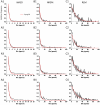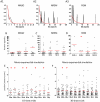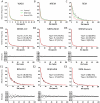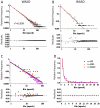Obstructive sleep apnea alters sleep stage transition dynamics
- PMID: 20596541
- PMCID: PMC2893208
- DOI: 10.1371/journal.pone.0011356
Obstructive sleep apnea alters sleep stage transition dynamics
Abstract
Introduction: Enhanced characterization of sleep architecture, compared with routine polysomnographic metrics such as stage percentages and sleep efficiency, may improve the predictive phenotyping of fragmented sleep. One approach involves using stage transition analysis to characterize sleep continuity.
Methods and principal findings: We analyzed hypnograms from Sleep Heart Health Study (SHHS) participants using the following stage designations: wake after sleep onset (WASO), non-rapid eye movement (NREM) sleep, and REM sleep. We show that individual patient hypnograms contain insufficient number of bouts to adequately describe the transition kinetics, necessitating pooling of data. We compared a control group of individuals free of medications, obstructive sleep apnea (OSA), medical co-morbidities, or sleepiness (n = 374) with mild (n = 496) or severe OSA (n = 338). WASO, REM sleep, and NREM sleep bout durations exhibited multi-exponential temporal dynamics. The presence of OSA accelerated the "decay" rate of NREM and REM sleep bouts, resulting in instability manifesting as shorter bouts and increased number of stage transitions. For WASO bouts, previously attributed to a power law process, a multi-exponential decay described the data well. Simulations demonstrated that a multi-exponential process can mimic a power law distribution.
Conclusion and significance: OSA alters sleep architecture dynamics by decreasing the temporal stability of NREM and REM sleep bouts. Multi-exponential fitting is superior to routine mono-exponential fitting, and may thus provide improved predictive metrics of sleep continuity. However, because a single night of sleep contains insufficient transitions to characterize these dynamics, extended monitoring of sleep, probably at home, would be necessary for individualized clinical application.
Conflict of interest statement
Figures





Similar articles
-
Probabilistic sleep architecture models in patients with and without sleep apnea.J Sleep Res. 2012 Jun;21(3):330-41. doi: 10.1111/j.1365-2869.2011.00937.x. Epub 2011 Sep 28. J Sleep Res. 2012. PMID: 21955148 Free PMC article.
-
Power law versus exponential state transition dynamics: application to sleep-wake architecture.PLoS One. 2010 Dec 2;5(12):e14204. doi: 10.1371/journal.pone.0014204. PLoS One. 2010. PMID: 21151998 Free PMC article.
-
NREM-AHI greater than REM-AHI versus REM-AHI greater than NREM-AHI in patients with obstructive sleep apnea: clinical and polysomnographic features.Sleep Breath. 2011 Sep;15(3):463-70. doi: 10.1007/s11325-010-0358-z. Epub 2010 May 6. Sleep Breath. 2011. PMID: 20443068
-
Unique sleep-stage transitions determined by obstructive sleep apnea severity, age and gender.J Sleep Res. 2020 Apr;29(2):e12895. doi: 10.1111/jsr.12895. Epub 2019 Jul 25. J Sleep Res. 2020. PMID: 31347213
-
Depressive symptoms and obesity as predictors of sleepiness and quality of life in patients with REM-related obstructive sleep apnea: cross-sectional analysis of a large clinical population.Sleep Med. 2011 Oct;12(9):827-31. doi: 10.1016/j.sleep.2011.08.003. Epub 2011 Oct 5. Sleep Med. 2011. PMID: 21978724
Cited by
-
Deep learning for automated sleep staging using instantaneous heart rate.NPJ Digit Med. 2020 Aug 20;3:106. doi: 10.1038/s41746-020-0291-x. eCollection 2020. NPJ Digit Med. 2020. PMID: 32885052 Free PMC article.
-
Sleep Fragmentation and the Risk of Incident Alzheimer's Disease and Cognitive Decline in Older Persons.Sleep. 2013 Jul 1;36(7):1027-1032. doi: 10.5665/sleep.2802. Sleep. 2013. PMID: 23814339 Free PMC article.
-
Accuracy of Fitbit Wristbands in Measuring Sleep Stage Transitions and the Effect of User-Specific Factors.JMIR Mhealth Uhealth. 2019 Jun 6;7(6):e13384. doi: 10.2196/13384. JMIR Mhealth Uhealth. 2019. PMID: 31172956 Free PMC article.
-
Sleep Spindle Characteristics in Obstructive Sleep Apnea Syndrome (OSAS).Front Neurol. 2021 Feb 25;12:598632. doi: 10.3389/fneur.2021.598632. eCollection 2021. Front Neurol. 2021. PMID: 33716919 Free PMC article.
-
LPS and its relationship with subjective-objective discrepancies of sleep onset latency in patients with psychiatric disorders.Sci Rep. 2023 Dec 19;13(1):22637. doi: 10.1038/s41598-023-49261-4. Sci Rep. 2023. PMID: 38114534 Free PMC article.
References
-
- Mahowald MW, Schenck CH. Insights from studying human sleep disorders. Nature. 2005;437:1279–1285. - PubMed
-
- Fuller PM, Gooley JJ, Saper CB. Neurobiology of the sleep-wake cycle: sleep architecture, circadian regulation, and regulatory feedback. J Biol Rhythms. 2006;21:482–493. - PubMed
-
- Espana RA, Scammell TE. Sleep neurobiology for the clinician. Sleep. 2004;27:811–820. - PubMed
-
- Chervin RD, Aldrich MS. The Epworth Sleepiness Scale may not reflect objective measures of sleepiness or sleep apnea. Neurology. 1999;52:125–131. - PubMed
Publication types
MeSH terms
Grants and funding
LinkOut - more resources
Full Text Sources
Medical

